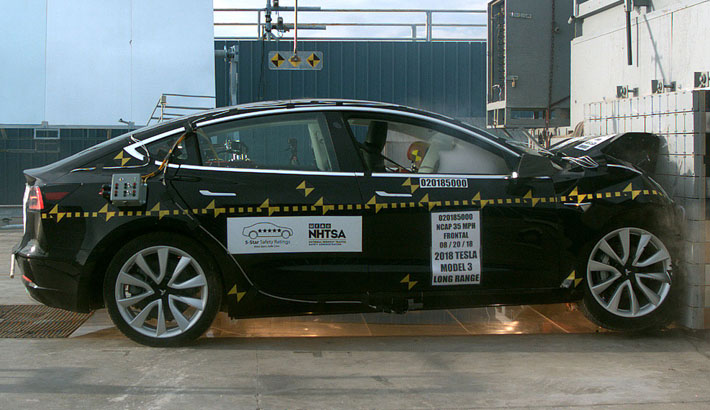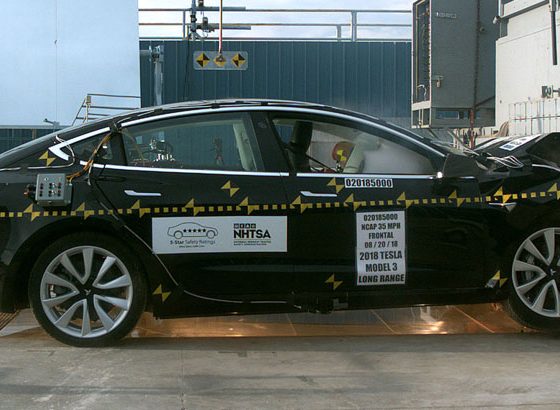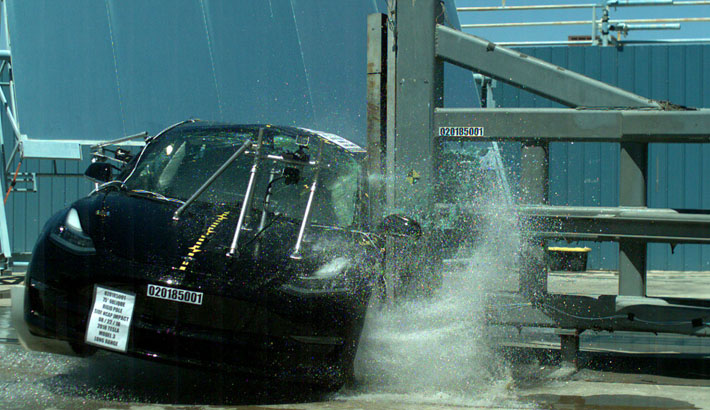

News
Tesla Model 3 named as vehicle with ‘lowest probability of injury’ by the NHTSA
The National Highway Traffic Safety Administration (NHTSA) has dubbed the Long Range RWD Tesla Model 3 as the vehicle with the lowest probability of injury among all cars that the agency has tested so far. The Model 3’s low likelihood of injury rating was given after the vehicle went through the NHTSA’s New Car Assessment Program, which involves a series of crash tests determining the likelihood of serious passenger injury for front, side, and rollover crashes.
The Model 3’s stellar rating from the NHTSA could be seen as yet another testament to the quality of Tesla’s all-electric cars. Immediately following the Model 3’s scores, after all, are the Model S and Model X, which are currently the vehicles considered by the NHTSA with the second and third lowest probabilities of injury. In a blog post announcing the electric sedan’s safety ratings, Tesla noted that it expects the Dual Motor AWD Model 3 to perform just as well in the NHTSA’s tests as its Long Range RWD sibling.
Part of the reason why the Model 3 is so safe is due to the vehicle’s all-electric design. Tesla opted to place the Model 3’s battery pack, the heaviest component of the vehicle, right at the car’s center of gravity. This gives the Model 3 performance and handling that is almost similar to that of mid-engine vehicles, while allowing the electric sedan to have a near 50/50 weight distribution. Other subtle design tweaks, such as the rear motor being placed slightly in front of the axle, further improve the Model 3’s weight distribution, as well as its overall agility and handling.
Model 3 provides superior safety with its front crumple zone which is optimized to absorb energy and crush upon impact https://t.co/RJEn0LlVNi pic.twitter.com/foF7CXPCc0
— Tesla (@Tesla) October 8, 2018
In true Tesla tradition, the Model 3’s all-electric architecture comprises of a sturdy, rigid passenger compartment, a fortified battery pack, and a low center of gravity. Just like its larger siblings, the Model S and X, the absence of an internal combustion engine in front and a fuel tank at the rear give the Model 3 extra large crumple zones, which are optimized to absorb energy and crush more efficiently in the event of an accident.
In the event of a frontal crash, the crumple zone at the front of the vehicle controls the deceleration of occupants, while the Model 3’s advanced restraint systems keep occupants safe in place. Passenger airbags are even specially designed to protect an occupant’s head in the event of an angled or offset crash, while active vents enable the vehicle to adjust the internal pressure of the frontal airbags when deploying. These systems optimize protection based on the specifics of an accident.
The Model 3’s energy-absorbing lateral and diagonal beam structures help occupants safe during pole impact crashes. These structures include a high-strength aluminum bumper beam, a sway bar placed close and forward in front of the car, cross members are the front of the steel subframe that are connected to the main crash fails, as well as diagonal beams in the subframe that distribute energy back to the crash rails when they are not directly impacted. An ultra-high-strength martensitic steel beam is further fitted on the front of the suspension to absorb crash energy from severe impacts.

Tesla also designed the Model 3 with a patented pillar structure and side sills to absorb as much energy as possible in a short distance. Coupled with the vehicle’s rigid body construction and fortified battery architecture, these design elements enable the Model 3 to reduce and prevent compartment intrusion in the event of an accident, while allowing its side airbags to have more space to inflate and cushion occupants.
Just like the Model S and Model X, the Model 3’s low center of gravity plays a key role in keeping the vehicle safe from rollover crashes. That said, even if a rollover does occur, Tesla notes that internal tests have shown that the Model 3 is capable of withstanding roof-crush loads equivalent to more than four times the electric sedan’s weight, far more than the NHTSA’s standards that require cars to withstand three times their own weight.
.@NHTSAgov will post final safety probability stats soon. Model 3 has a shot at being safest car ever tested.
— Elon Musk (@elonmusk) September 20, 2018
The Model 3 was recently given a flawless 5-Star Safety Rating in all categories and subcategories by the NHTSA. In a follow-up tweet to the NHTSA’s Model 3 results, Elon Musk noted on Twitter that the electric sedan has a shot at being the “safest car ever tested” by the agency. With the Model 3 being dubbed as the vehicle with the lowest probability of injury by the NHTSA, it appears that Musk’s statement has proven to be accurate.
Model 3 has the lowest intrusion from side pole impact of any vehicle tested by @NHTSAgov https://t.co/RJEn0LlVNi pic.twitter.com/ZvGCC82rEX
— Tesla (@Tesla) October 8, 2018
It’s not just the NHTSA that has given the Model 3 its approval, either. Earlier this year, the Insurance Institute for Highway Safety (IIHS), a nonprofit funded by auto insurers aimed at reducing accidents on the road, gave the Model 3 a “Superior” front crash avoidance rating. During the course of its testing, the Model 3 performed well in the crash avoidance and mitigation category, thanks to the vehicle’s Forward Collision Warning, its low-speed autobrake, and its high-speed autobrake systems. The Model 3 was also given a “Recommended” rating by Consumer Reports, after an over-the-air software update reduced the vehicle’s braking distance.
Tesla’s electric cars are known for their performance and their safety. The Model X, for one, also received 5-Star Safety Ratings in all categories and subcategories during the NHTSA’s tests. The Model S, on the other hand, performed so well during the NHTSA’s safety evaluation that the agency’s crash-testing gear broke while it was testing the electric sedan.

News
Tesla hints at Starlink integration with recent patent
“By employing polymer blends, some examples enable RF transmission from all the modules to satellites and other communication devices both inside and outside the vehicle.”

Tesla hinted at a potential Starlink internet terminal integration within its vehicles in a recent patent, which describes a vehicle roof assembly with integrated radio frequency (RF) transparency.
The patent, which is Pub. No U.S. 2025/0368267 describes a new vehicle roof that is made of RF-transparent polymer materials, allowing and “facilitating clear communication with external devices and satellites.”
Tesla believes that a new vehicle roof design, comprised of different materials than the standard metallic or glass elements used in cars today, would allow the company to integrate modern vehicular technologies, “particularly those requiring radio frequency transmission and reception.
Tesla has recently filed a US patent application on integrating RF transparent materials into the roof structure.
“facilitating clear communication with external devices and satellites”
Tesla fleet is getting @Starlink connectivity integration soon. LFG @Tesla @elonmusk… pic.twitter.com/bLa8YtPLd1
— Chansoo Byeon (@Chansoo) December 9, 2025
Instead of glass or metallic materials, Tesla says vehicles may benefit from high-strength polymer blends, such as Polycarbonate, Acrylonitrile Butadiene Styrene, or Acrylonitrile Styrene Acrylate.
These materials still provide ideal strength metrics for crashworthiness, stiffness for noise, vibration, and harshness control, and are compliant with head impact regulations.
They would also enable better performance with modern technologies, like internet terminals, which need an uninterrupted signal to satellites for maximum reception. Tesla writes in the patent:
“By employing polymer blends, some examples enable RF transmission from all the modules to satellites and other communication devices both inside and outside the vehicle.”

One of the challenges Tesla seems to be aware of with this type of roof design is the fact that it will still have to enable safety and keep that at the forefront of the design. As you can see in the illustration above, Tesla plans to use four layers to increase safety and rigidity, while also combating noise and vibration.
It notes in the patent that disclosed examples still meet the safety requirements outlined in the Federal Motor Vehicle Safety Standards (FMVSS).
Starlink integrated directly into Tesla vehicles would be a considerable advantage for owners. It would come with a handful of distinct advantages.
Initially, the inclusion of Starlink would completely eliminate cellular dead zones, something that is an issue, especially in rural areas. Starlink would provide connectivity in these remote regions and would ensure uninterrupted service during road trips and off-grid adventures.
It could also be a critical addition for Robotaxi, as it is crucial to have solid and reliable connectivity for remote monitoring and fleet management.
Starlink’s growing constellation, thanks to SpaceX’s routine and frequent launch schedule, will provide secure, stable, and reliable internet connectivity for Tesla vehicles.
Although many owners have already mounted Starlink Mini dishes under their glass roofs for a similar experience, it may be integrated directly into Teslas in the coming years, either as an upgrade or a standard feature.
News
Tesla supplements Holiday Update by sneaking in new Full Self-Driving version
It seems Tesla was waiting for the Hardware 4 rollout, as it wanted to also deploy a new Full Self-Driving version to those owners, as it appeared in the release notes for the Holiday Update last night.

Tesla has surprised some owners by sneaking in a new Full Self-Driving version with the wide release of the Holiday Update, which started rolling out to Hardware 4 owners on Friday night.
Tesla has issued a controlled and very slow release pattern with the Holiday Update, which rolls out with Software Version 2025.44.25.5.
For the past two weeks, as it has rolled out to Hardware 3 and older Tesla owners, the company has kept its deployment of the new Software Version relatively controlled.
It seems Tesla was waiting for the Hardware 4 rollout, as it wanted to also deploy a new Full Self-Driving version to those owners, as it appeared in the release notes for the Holiday Update last night.
Tesla Full Self-Driving v14.2.1.25 made its first appearance last night to Hardware 4 owners who are members of the Early Access Program (EAP). It appears to be a slight refinement from FSD v14.2.1, which has been out for a couple of weeks.
Tesla v2025.44.25.5 Holiday update incoming
Also Full Self-Driving v14.2.1.25!!! pic.twitter.com/74D7S0UGXz
— TESLARATI (@Teslarati) December 13, 2025
Many owners welcome the new FSD version, us included, because we’ve been less than impressed with v14.2.1. We have experienced some minor regressions with v14.2.1, especially with Speed Limit recognition, Speed Profile tinkering, and parking performance.
As it stands, Full Self-Driving is still particularly impressive, but Tesla is evidently having an issue with some of the adjustments, as it is still refining some of the performance aspects of the suite. This is expected and normal with some updates, as not all of them are an improvement in all areas; we routinely see some things backtrack every once in a while.
This new FSD version is likely to take care of those things, but it also includes all of the awesome Holiday Update features, which include:
- Grok with Navigation Commands (Beta) – Grok will now add and edit destinations.
- Tesla Photobooth – Take pictures inside your car using the cabin-facing camera
- Dog Mode Live Activity – Check on your four-legged friend on your phone through periodic snapshots taken of the cabin
- Dashcam Viewer Update – Includes new metrics, like steering wheel angle, speed, and more
- Santa Mode – New graphics, trees, and a lock chime
- Light Show Update – Addition of Jingle Rush light show
- Custom Wraps and License Plates – Colorizer now allows you to customize your vehicle even further, with custom patterns, license plates, and tint
- Navigation Improvements – Easier layout and setup
- Supercharger Site Map – Starting at 18 pilot locations, a 3D view of the Supercharger you’re visiting will be available
- Automatic Carpool Lane Routing – Navigation will utilize carpool lanes if enabled
- Phone Left Behind Chime – Your car will now tell you if you left a phone inside
- Charge Limit Per Location – Set a charge limit for each location
- ISS Docking Simulator – New game
- Additional Improvements – Turn off wireless charging pad, Spotify improvements, Rainbow Rave Cave, Lock Sound TRON addition
Tesla also added two other things that were undocumented, like Charging Passport and information on USB drive storage to help with Dashcam.
Cybertruck
Tesla updates Cybertruck owners about key Powershare feature

Tesla is updating Cybertruck owners on its timeline of a massive feature that has yet to ship: Powershare with Powerwall.
Powershare is a bidirectional charging feature exclusive to Cybertruck, which allows the vehicle’s battery to act as a portable power source for homes, appliances, tools, other EVs, and more. It was announced in late 2023 as part of Tesla’s push into vehicle-to-everything energy sharing, and acting as a giant portable charger is the main advantage, as it can provide backup power during outages.
Cybertruck’s Powershare system supports both vehicle-to-load (V2L) and vehicle-to-home (V2H), making it flexible and well-rounded for a variety of applications.
However, even though the feature was promised with Cybertruck, it has yet to be shipped to vehicles. Tesla communicated with owners through email recently regarding Powershare with Powerwall, which essentially has the pickup act as an extended battery.
Powerwall discharge would be prioritized before tapping into the truck’s larger pack.
However, Tesla is still working on getting the feature out to owners, an email said:
“We’re writing to let you know that the Powershare with Powerwall feature is still in development and is now scheduled for release in mid-2026.
This new release date gives us additional time to design and test this feature, ensuring its ability to communicate and optimize energy sharing between your vehicle and many configurations and generations of Powerwall. We are also using this time to develop additional Powershare features that will help us continue to accelerate the world’s transition to sustainable energy.”
Owners have expressed some real disappointment in Tesla’s continuous delays in releasing the feature, as it was expected to be released by late 2024, but now has been pushed back several times to mid-2026, according to the email.
Foundation Series Cybertruck buyers paid extra, expecting the feature to be rolled out with their vehicle upon pickup.
Cybertruck’s Lead Engineer, Wes Morrill, even commented on the holdup:
As a Cybertruck owner who also has Powerwall, I empathize with the disappointed comments.
To their credit, the team has delivered powershare functionality to Cybertruck customers who otherwise have no backup with development of the powershare gateway. As well as those with solar…
— Wes (@wmorrill3) December 12, 2025
He said that “it turned out to be much harder than anticipated to make powershare work seamlessly with existing Powerwalls through existing wall connectors. Two grid-forming devices need to negotiate who will form and who will follow, depending on the state of charge of each, and they need to do this without a network and through multiple generations of hardware, and test and validate this process through rigorous certifications to ensure grid safety.”
It’s nice to see the transparency, but it is justified for some Cybertruck owners to feel like they’ve been bait-and-switched.








